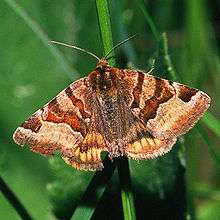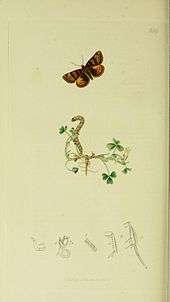Burnet companion moth
| Burnet companion moth | |
|---|---|
 | |
| Scientific classification | |
| Kingdom: | Animalia |
| Phylum: | Arthropoda |
| Class: | Insecta |
| Order: | Lepidoptera |
| Family: | Erebidae |
| Subfamily: | Erebinae |
| Tribe: | Euclidiini |
| Genus: | Euclidia |
| Species: | E. glyphica |
| Binomial name | |
| Euclidia glyphica (Linnaeus, 1758)[1] | |
| Synonyms | |
| |
The burnet companion moth (Euclidia glyphica) is a moth of the Erebidae family. It is found in most of the Palearctic ecozone from Ireland in the west to Mongolia and Siberia in the east, south to the Mediterranean and North Africa.[2][3]


Technical Description and variation
- See glossary for terms used
Forewing pale grey suffused with pale brown or uniform pale brown; the shadings dark olive brown; inner line pale, oblique and waved, followed by a brown band; outer line whitish, vertically waved, preceded by a brown band, the inner edge of which is the median line; at costa the outer line is excurved and accompanied by pale scales on each side; submarginal line obscure, followed by a darker diffuse band, forming a black blotch on costa: hindwing orange, the veins dark; base and inner margin fuscous; a blackish submarginal band, outwardly toothed at costa and middle; a dark terminal shade running up along veins.The more uniformly dark brown examples constitute the ab. suffusa Spul., the usual form in Britain; -ab. marginata Spul.has the subterminal area whitish ochreous; in the ab. obsoleta Strand the dark bands of the underside are wanting; the ab. tristicula Schultz is much darker than the type.[4]
Biology
Larva yellowish brown or reddish brown; the dorsal line darker; head yellowish brown with two dark streaks. The larvae feed on Viola, Trifolium species (especially Trifolium pratense), Medicago sativa, Lotus corniculatus, Vicia cracca, Lathyrus pratensis, and Hippocrepis comosa.[5]
References
- ↑ taxapad.com
- ↑ Funet
- ↑ Fauna Europaea
- ↑ Seitz, A. Ed., 1914 Die Großschmetterlinge der Erde, Verlag Alfred Kernen, Stuttgart Band 3: Abt. 1, Die Großschmetterlinge des palaearktischen Faunengebietes, Die palaearktischen eulenartigen Nachtfalter, 1914
- ↑ Heiko Bellmann, 2003 Der Neue Kosmos Schmetterlingsführer, Schmetterlinge, Raupen und Futterpflanzen, S. 260, Franckh-Kosmos Verlags-GmbH & Co, Stuttgart 2003, ISBN 3-440-09330-1
External links
| Wikispecies has information related to: Burnet companion moth |
| Wikimedia Commons has media related to Burnet companion moth. |